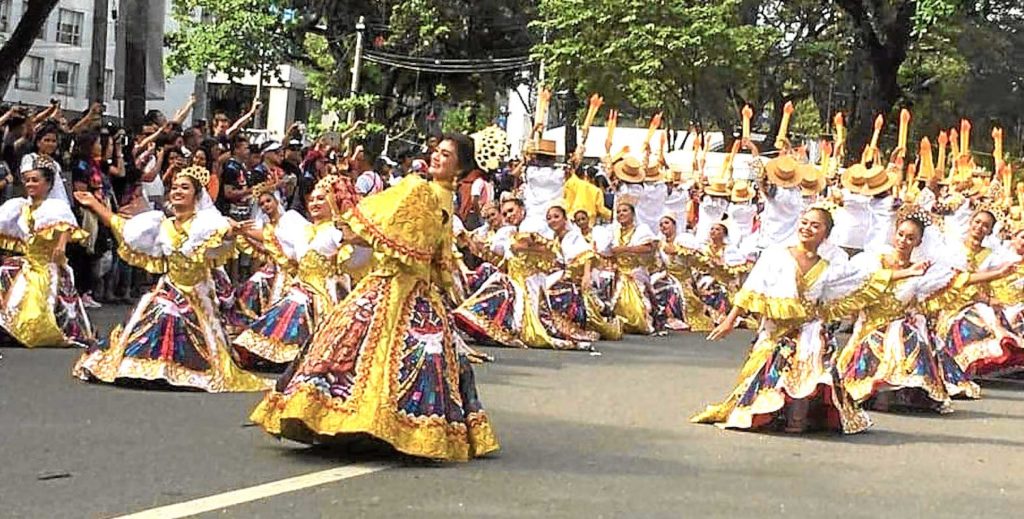Canceled Sinulog, Ati-Atihan: Sto. Niño is in the heart

Dancers honor the Sto. Niño during a Sinulog festival parade, which has been canceled this year. INQUIRER FILE
Nothing is lost. When all physical festivals, the biggest, and brightest events of the Sinulog, were canceled due to the continued threat of Covid-19 and when no street dancing parade and no grand ritual showdown were allowed, nothing has been lost – 2021 is just another year in the eternity of God and next year will be better.
Besides, for those who are searching for God, behold, He is not present in a powerful wind that tore the mountains apart and shattered the rocks, neither in an earthquake nor in a fire. Be reminded, dear Cebuanos and Aklanons, that God is present in “a gentle whisper” (1 Kings 19:11-13).
“A gentle whisper” may mean a prayer of the heart, a tête-à-tête with God in the silence of your room with your family, where your smartphone is put off even for a while. “A gentle whisper” may also mean recalling the fundamental reason why we enjoy Sinulog during this time of the year.
The pandemic has brought a whirlwind of transformations, both affecting us in the most despicable manner and challenging us at the way we celebrate our faith. Yet Christian Faith is what it is, I dare say, the same Faith that makes us trust the providence of Poong Maykapal even in the midst of the persistently tenacious phenomena such as typhoons, earthquakes, volcano eruptions, EJK, horrendous traffic, Covid-19 and its new variants. It’s the same Faith in God that sustained our forebears when, in 1521, Datu Lapu-Lapu and his men killed Magellan, when the newly baptized Rajah Humabon of Cebu poisoned the Spanish soldiers and literally wiped out almost all the remnants of the Magellan expedition.
Perhaps a blessing in disguise, this year has given us more time to reflect that, when the expedition led by Miguel López de Legaspi arrived on February 13, 1565, encountered strong resistance from the natives, and the Spanish soldiers for several weeks unforgivingly bombarded and burned down the whole coastal town of Cebu. Full stop! Now, feel the power of YHWH God in history as we recall those events. During the mapping operations on April 28, 1565, from the burned ruins, the Spanish soldier Juan Camus under Legazpi’s command discovered or found (kaplag in Cebuano) the Sto. Niño in a wooden box, and turned it over to Fray Urdaneta, OSA. It was the same miraculous image that Magellan gave Hara Humanay 44 years earlier!
Legaspi shared his joy with the Spanish King in his report: “This was kept in its cradle, all gilded, just as if it were brought from Spain: and only the little cross, which is generally placed upon the globe in his hands, was lacking. The image was well kept in that house, and many flowers were found before it, and no one knows for what object or purpose. The soldier bowed down before it with all reverence and wonder, and brought the image to the place where the other soldiers were” (Relatio, Julio de 1569).
Kaplag indeed has been one of God’s surprises in Philippine history. We believe in our hearts that the discovery provided an exclamation point in the history of the Filipino Church because, simply put, no kaplag of the image in 1565 means there’s no Sto. Niño devotion in the country. You cannot imagine Cebu without the Basilica Minore, and it is not even possible to think of Iloilo, Aklan, or Tondo, the mayor’s office, jeepneys, every parish, or the entire Philippines without the Sto. Niño.
Led by Fr. Diego de Herrera, OSA, the pioneering Augustinian missionaries that accompanied Legazpi built a church on the site where the holy image was found, then called San Agustin Church, which is today’s Basilica Minore del Santo Niño. For good reason, the Vatican designated the present concrete building, which was completed from 1739–1740, to be the “Mother and Head of all Churches in the Philippines,” Mater et Caput… omnium ecclesiarum insularum Philippinarum. When St. Paul VI elevated the church into a basilica in 1965, he declared it to be “the symbol of the birth and growth of Christianity in the Philippines.”
Hala bira! Five solid centuries after, devotees still spiritually experience the deep impact of that discovery as we join and enjoy the Sinulog-Santo Niño festivities held on the third Sunday of January in Cebu and Dinagyang of Iloilo, both are said to be adaptations of the Kalibo’s Ati-Atihan Festival – only this time in a more reflective mode.
Let us celebrate another episode of God writing straight with twists and turns in the Filipino history.
Jose Mario Bautista Maximiano (facebook.com/josemario.maximiano) is the author of MCMLXXII: 500-Taong Kristiyano. Volume Two (2021) and MDXXI: 500 YEARS ROMAN CATHOLIC, Volume One (Claretian, 2020).

